Covert Agency Manipulation
COINTELPRO, short for Counter Intelligence Program, was a series of covert and often illegal projects conducted by the FBI from 1956 to 1971, aimed at surveilling, infiltrating, discrediting, and disrupting domestic American political organizations deemed subversive.
Authorized by FBI Director J. Edgar Hoover, it targeted groups like the Communist Party USA, civil rights movements (including Martin Luther King Jr.), Black Panther Party, American Indian Movement, and anti-Vietnam War organizers, among others.The program used tactics like wiretapping, smear campaigns, forged documents, psychological warfare, and encouraging violence between groups (e.g., between the Black Panthers and other organizations).
Notable examples include attempts to discredit MLK by spreading false information about his personal life and pressuring him to commit suicide. COINTELPRO’s actions often violated civil liberties and constitutional rights.It was exposed in 1971 when activists stole documents from an FBI office in Media, Pennsylvania, and leaked them to the press.
This led to public outcry, congressional investigations (notably the Church Committee in 1975), and the program’s official termination. However, its legacy raised lasting concerns about government overreach and surveillance of citizens.
MKUltra was a covert CIA program, officially running from 1953 to 1973, focused on developing mind control and interrogation techniques through human experimentation. Authorized by CIA Director Allen Dulles, it aimed to counter perceived Soviet and Chinese advances in brainwashing during the Cold War. The program involved illegal and unethical experiments on unwitting subjects, including U.S. and Canadian citizens.Key aspects:
-
Experiments: MKUltra tested drugs (notably LSD), hypnosis, sensory deprivation, electroshock, and psychological manipulation. Subjects included prisoners, mental patients, and unaware civilians, often without consent.
-
Scope: It spanned 80+ institutions, including universities, hospitals, and prisons, with 44 colleges involved. Over 150 subprojects explored everything from chemical interrogation to behavioral modification.
-
Notable Cases: Experiments like dosing people with LSD in public settings (e.g., Operation Midnight Climax in San Francisco) or the death of Frank Olson, a scientist who was unknowingly given LSD and later died under suspicious circumstances, highlight the program’s recklessness.
-
Secrecy and Destruction: In 1973, CIA Director Richard Helms ordered most MKUltra records destroyed, leaving limited documentation. Surviving details emerged through 1975 Freedom of Information Act requests and investigations.
The program was exposed publicly during the 1975 Church Committee hearings, alongside COINTELPRO, revealing gross violations of ethics and civil rights. It was officially halted, but its legacy fuels distrust in government and speculation about continued covert programs.
The following is a fictionalized storyboard outlining potential Covert Programs, fictionalized to avoid legal or other repercussions. But feel free to read between the lines. The setting is somewhere else.
“Invisible hands leave visible fingerprints.”
“The Architects of Influence”
The Setting: Republica
A modern democratic nation, constantly on edge. Its people vote, protest, and dream freely — but shadows linger behind the curtain.
1. The Watchtower Agency
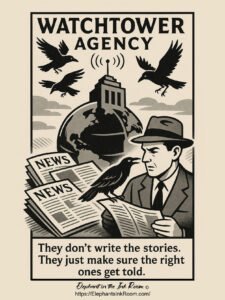
(Inspired by the CIA)
A secretive agency born after the Great War. Officially foreign-focused, it keeps Republica safe. Unofficially, it seeds coups abroad and whispers narratives at home.
Key Tactic: “Feather & Quill” — placing storytellers in key media posts to control the plotline without writing it themselves.
-
Notable Operation: “Mockbird” — where agents whispered headlines into trusted ears, shaping what the people feared, hated, and ignored.
-
Modern Twist: Funded a network of independent news “hubs” that subtly echoed official lines with a local accent.
2. The Sentinel Bureau
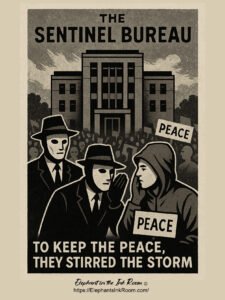
(Inspired by the FBI)
Meant to defend from internal sabotage, but often defined what “subversion” meant based on the politics of the day.
Key Tactic: “Echo Disruption” — infiltrating activist circles and sowing paranoia, false friendships, and betrayal.
-
Notable Operation: “Harpy” — a campaign to dismantle the Unity March Movement by labeling them enemies of order and peace.
-
Fallout: The movement imploded from within; the leaders never fully trusted each other again.
3. The Listening Vault
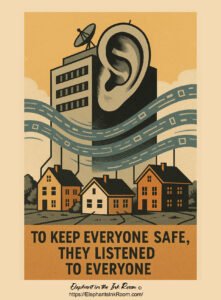
(Inspired by the NSA)
A faceless cathedral of code. It doesn’t act — it watches, collects, connects.
“If you whisper, they can hear it. If you think it, they may predict it.”
Key Tactic: “Mind Lattice” — linking data from every citizen into behavioral profiles for “national security modeling.”
-
Revelation: A rogue technician leaked the truth to the public. Instead of outrage, the people shrugged. “If you have nothing to hide…”
4. The Forge
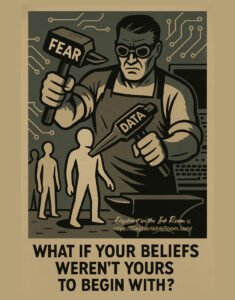
(Inspired by Cambridge Analytica, military psyops, and political data firms)
A private, unregulated lab where public will is melted and recast into programmable segments.
Key Tactic: “Soul Maps” — personalized emotional profiles built from likes, clicks, and idle complaints.
“They don’t sell ads — they sell certainty.”
-
Use Case: A political faction buys access before the election, deploying fear-based ads to suppress enemy voters and ignite their own.
5. The Ministry of Tomorrow
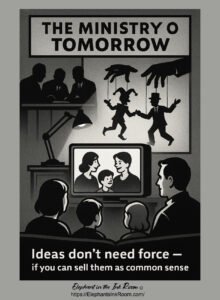
(A fictional mashup of think tanks, media outlets, and social platforms)
Not officially government. Not officially anything. But its ideas somehow always reach the top.
Key Tactic: “Consensus Sculpting” — the art of turning radical ideas into breakfast-table common sense.
“The people chose it — we just helped them want it.”
-
Example: A new law restricts protest zones. Within a week, every morning show host is saying “Well, you can’t just let mobs run the streets…”
Epilogue Chapter: The Mirror Room
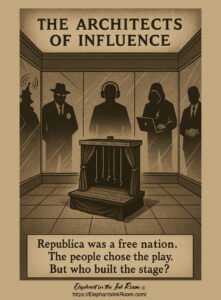
A small room beneath the Capitol of Republica. No one lives there — but the walls reflect every decision made upstairs.
In the center, a marionette stage, strings dangling. But no puppets.
The message?
“If the people believe they chose the show, do they need to know who built the stage?”
Republica isn’t real. But the shadows behind it often are.
We’re not told to think anymore — just to choose sides.
But when the stage is rigged and the script already written… what good is a vote?

